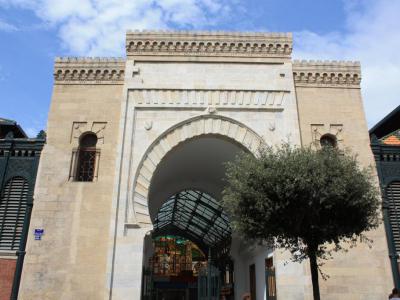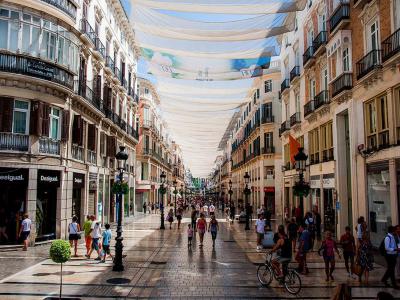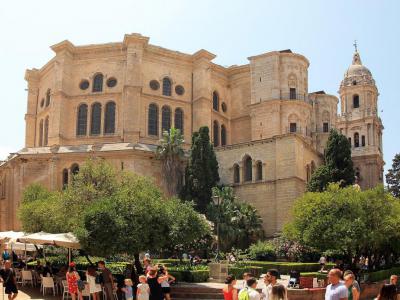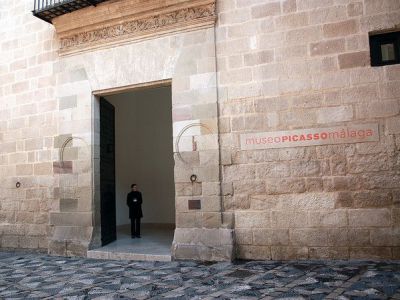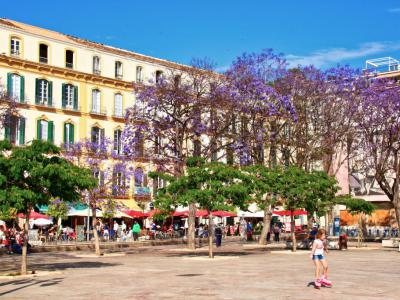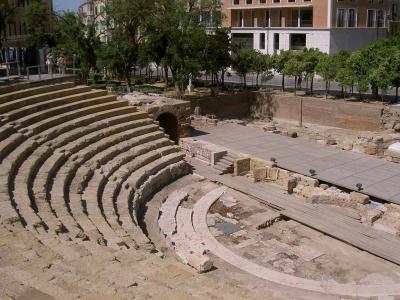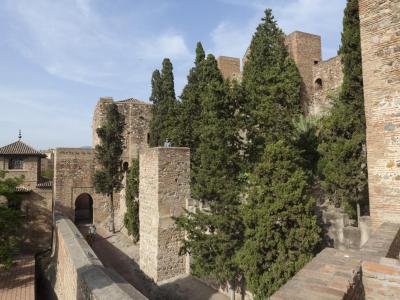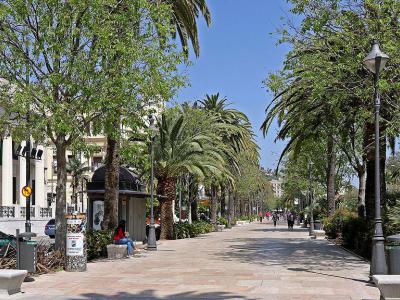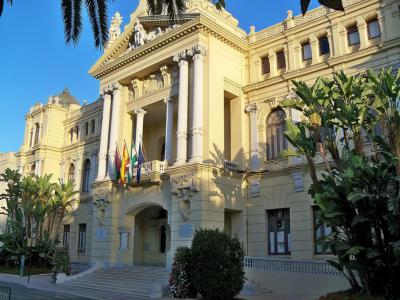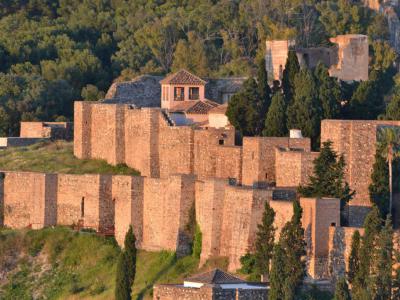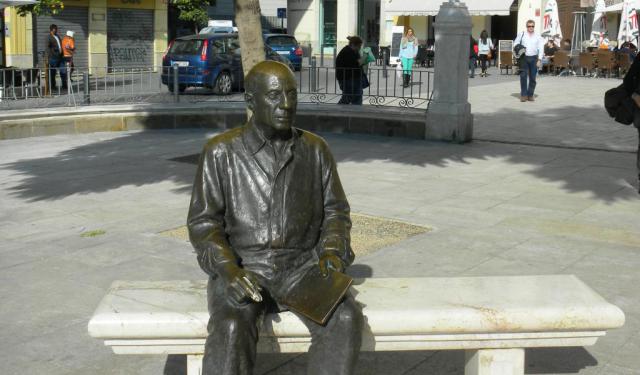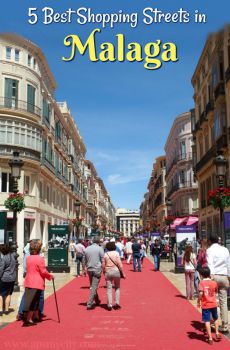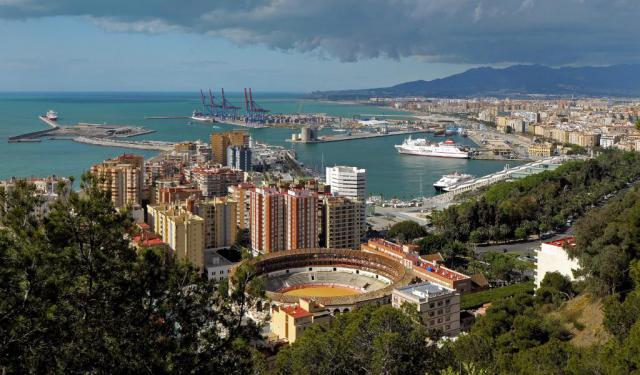
Malaga Introduction Walking Tour (Self Guided), Malaga
Malaga is old. It is 2,800 years old. It is thought to have been founded by Phoenician traders in 770 BC. From its beginnings, it was a natural waypoint between Phoenicia in the eastern Mediterranean and Gibraltar. Cathaginians and, later, Romans ruled the city. Their core settlements were in an area between Gibralfaro Hill to the Guadalmedina River.
From the eighth century to the end of the 15th century, the city was ruled by several Islamic kingdoms and caliphates. The Abassids, the Umayyads, the Taifa, and the Nasrids jostled each other for control of Al Andalus. In 1487 however, Ferdinand and Isabella marched into the city, planted their flag, and Malaga became Spanish.
To get a great overview of the old city, climb Gibralfaro Hill to Gibalrfaro Castle and the Alcazaba Fortress. The hill is 427 feet high and affords a good perspective of things below. Sites to be visited include the Gothic-Mudejar Church of Santiago, the Roman Theatre, the old Jewish quarter, and the Park of Malaga that runs alongside the harbor.
Visit Larios Street, the main commercial street of Malaga. There are museums like the Municipal Museum of Malaga and the Carmen Thyssen Museum in the Villalon Palace. A must-see is Malaga Picasso Museum at the Buenavista Palace.
Holiday festivals are unique. Holy Week has been observed in Malaga for five hundred years. Processions start on Palm Sunday and continue until Easter Sunday. During August, the streets are filled with the Malaga Carnival. There is dancing and music, flamenco or verdiales. There is Carnival and Spain's own April Fools' Day.
In 1325, the famous Muslim traveler Ibn Battuta reflected on his visit to Malaga. "It is one of the largest and most beautiful towns of Andalusia combining the conveniences of both sea and land." Are Battuta's words true today? Come and see for yourself.
From the eighth century to the end of the 15th century, the city was ruled by several Islamic kingdoms and caliphates. The Abassids, the Umayyads, the Taifa, and the Nasrids jostled each other for control of Al Andalus. In 1487 however, Ferdinand and Isabella marched into the city, planted their flag, and Malaga became Spanish.
To get a great overview of the old city, climb Gibralfaro Hill to Gibalrfaro Castle and the Alcazaba Fortress. The hill is 427 feet high and affords a good perspective of things below. Sites to be visited include the Gothic-Mudejar Church of Santiago, the Roman Theatre, the old Jewish quarter, and the Park of Malaga that runs alongside the harbor.
Visit Larios Street, the main commercial street of Malaga. There are museums like the Municipal Museum of Malaga and the Carmen Thyssen Museum in the Villalon Palace. A must-see is Malaga Picasso Museum at the Buenavista Palace.
Holiday festivals are unique. Holy Week has been observed in Malaga for five hundred years. Processions start on Palm Sunday and continue until Easter Sunday. During August, the streets are filled with the Malaga Carnival. There is dancing and music, flamenco or verdiales. There is Carnival and Spain's own April Fools' Day.
In 1325, the famous Muslim traveler Ibn Battuta reflected on his visit to Malaga. "It is one of the largest and most beautiful towns of Andalusia combining the conveniences of both sea and land." Are Battuta's words true today? Come and see for yourself.
How it works: Download the app "GPSmyCity: Walks in 1K+ Cities" from Apple App Store or Google Play Store to your mobile phone or tablet. The app turns your mobile device into a personal tour guide and its built-in GPS navigation functions guide you from one tour stop to next. The app works offline, so no data plan is needed when traveling abroad.
Malaga Introduction Walking Tour Map
Guide Name: Malaga Introduction Walking Tour
Guide Location: Spain » Malaga (See other walking tours in Malaga)
Guide Type: Self-guided Walking Tour (Sightseeing)
# of Attractions: 13
Tour Duration: 2 Hour(s)
Travel Distance: 3.4 Km or 2.1 Miles
Author: HelenF
Sight(s) Featured in This Guide:
Guide Location: Spain » Malaga (See other walking tours in Malaga)
Guide Type: Self-guided Walking Tour (Sightseeing)
# of Attractions: 13
Tour Duration: 2 Hour(s)
Travel Distance: 3.4 Km or 2.1 Miles
Author: HelenF
Sight(s) Featured in This Guide:
- Plaza y Acera de La Marina (Marina Square and Sidewalk)
- Mercado de Atarazanas (Shipyards Market)
- Calle Larios (Larios Street)
- Plaza de la Constitución (Constitution Square)
- Museo Carmen Thyssen Malaga (Carmen Thyssen Museum)
- Catedral de Málaga (Malaga Cathedral)
- Museo Picasso Málaga (Picasso Museum)
- Plaza de la Merced (Merced Square)
- Teatro Romano (Roman Theatre)
- Alcazaba of Malaga (Malaga Fortress)
- Parque de Malaga (Park of Malaga)
- Ayuntamiento de Málaga (Malaga City Hall)
- Castillo de Gibralfaro (Gibralfaro Castle)
1) Plaza y Acera de La Marina (Marina Square and Sidewalk)
Jaime Fernandez Pimentel wanted to memorialize "Diego" the "cenachero" who sold fish from baskets in front of Jaime's childhood home on Carreteria Street. There are no more cenacheros, but Jaime's statue of Diego stands today, a lasting symbol of Malaga, in the Marina Square, a popular square in the Centro district of the city.
The Marina Square is a major nexus of the city. It intersects with the Alameda Principal, the Paseo del Parque, and Molina Lario Street, with access to the Port of Malaga. The square was originally designed in 1848. Land was reclaimed from the sea and the old walls from the Nasrid era were demolished.
Plaza de la Marina is the original name of the square. Since 1848 the area name has changed twice. It became Plaza de la Marina again in 1942 as the square was remodeled and expanded, buildings demolished and a fountain installed.
In 1984 there was more remodeling. Underground parking and a garden were installed. There is now a tourist office and a skateboarding area in the plaza. In the future the Port of Malaga will be merged with the park and the square will be completely pedestrianized.
The Marina Square is a major nexus of the city. It intersects with the Alameda Principal, the Paseo del Parque, and Molina Lario Street, with access to the Port of Malaga. The square was originally designed in 1848. Land was reclaimed from the sea and the old walls from the Nasrid era were demolished.
Plaza de la Marina is the original name of the square. Since 1848 the area name has changed twice. It became Plaza de la Marina again in 1942 as the square was remodeled and expanded, buildings demolished and a fountain installed.
In 1984 there was more remodeling. Underground parking and a garden were installed. There is now a tourist office and a skateboarding area in the plaza. In the future the Port of Malaga will be merged with the park and the square will be completely pedestrianized.
2) Mercado de Atarazanas (Shipyards Market) (must see)
When is a shipyard not a shipyard? When there are no ships in the yard, or there is no yard and there is no water and it's really a market. But during the rule of Mohammed V (1354-1391} the market was actually a shipyard. With seven stone horseshoe arches, it was among the most impressive buildings around.
Only one arch is still there. It serves as the entrance to the Shipyards Market. There are a couple of small shields at the top of the arch with the inscription in Arabic, "Only God is the victor, glory be to Him."
When the Catholics took over the city in 1487 the Atarazanas was used as a convent. The sea was much closer then and the waves and the ships were perhaps too distracting. The convent was given up in favor of a military storage facility. Then it was a hospital and then a medical school. In 1868 the government said, "tear it down. Make a market."
Along came architect Joaquin Rucoba. He rebuilt the Atarazanas, keeping only one arch as the main entrance in the center of the south facade. The new market was done in an Arabic style with arched windows and panels and iron for stone. It also has inside a huge stained glass window showing the main sights of Malaga.
The market is bustling every day except Sunday from 8am to 2pm. Meats, fish, fresh fruit and vegetables are available in separate stalls. The market is not only a place for local products, it is also famous for its tapas.
Only one arch is still there. It serves as the entrance to the Shipyards Market. There are a couple of small shields at the top of the arch with the inscription in Arabic, "Only God is the victor, glory be to Him."
When the Catholics took over the city in 1487 the Atarazanas was used as a convent. The sea was much closer then and the waves and the ships were perhaps too distracting. The convent was given up in favor of a military storage facility. Then it was a hospital and then a medical school. In 1868 the government said, "tear it down. Make a market."
Along came architect Joaquin Rucoba. He rebuilt the Atarazanas, keeping only one arch as the main entrance in the center of the south facade. The new market was done in an Arabic style with arched windows and panels and iron for stone. It also has inside a huge stained glass window showing the main sights of Malaga.
The market is bustling every day except Sunday from 8am to 2pm. Meats, fish, fresh fruit and vegetables are available in separate stalls. The market is not only a place for local products, it is also famous for its tapas.
3) Calle Larios (Larios Street) (must see)
Someone in Malaga really liked Chicago buildings in the 1880s. Chief suspect might be Jose Maria Sancha, architect and designer of Calle Larios. Or, the Chicago architecture fan might also be Sancha's colleague, Manuel Rivera. But no. Building design was by Chicago enthusiast and Spanish Architect, Eduardo Strachan Viana-Cardenas.
The street is pedestrianized to encourage strolling and shopping, especially shopping. It extends from the Constitution Square in the north to Alameda Principal in the south. It is reputed to be the most expensive street to live on in Malaga, and one of the most expensive to live on throughout Spain.
In 1880 a corporation formed by the city to fund creation of the street raised over one million pesetas. Shares were 25,000 pesetas each. Most were purchased by the Larios family. It was to no-one's surprise that the street was named for Manuel Larios. A statue of him by Mariano Benlliure is at the south end of the street.
During the time of the Second Republic the street was briefly renamed "Calle 14 de Abril" for the date of the introduction of democracy. In the Spanish civil war the street was bombed but spared much architectural damage.
Larios Street is very popular. It is lined with banks, cafes and businesses. Besides the statue of Manuel Larios there is the sculpture of the Quiromantic Dove, by Jose Sigal.
The street is pedestrianized to encourage strolling and shopping, especially shopping. It extends from the Constitution Square in the north to Alameda Principal in the south. It is reputed to be the most expensive street to live on in Malaga, and one of the most expensive to live on throughout Spain.
In 1880 a corporation formed by the city to fund creation of the street raised over one million pesetas. Shares were 25,000 pesetas each. Most were purchased by the Larios family. It was to no-one's surprise that the street was named for Manuel Larios. A statue of him by Mariano Benlliure is at the south end of the street.
During the time of the Second Republic the street was briefly renamed "Calle 14 de Abril" for the date of the introduction of democracy. In the Spanish civil war the street was bombed but spared much architectural damage.
Larios Street is very popular. It is lined with banks, cafes and businesses. Besides the statue of Manuel Larios there is the sculpture of the Quiromantic Dove, by Jose Sigal.
4) Plaza de la Constitución (Constitution Square)
This is the beating heart of Malaga. The square in a sense has always been there. It was there at the time of the Reconquest, when it was called the Four Streets Square. Before 1812 it was named "Main Town Square." The city hall was once here along with the Mayor's home, the jail and the Covent de los Augustins.
In 2002 the Square and Larios Street were changed into pedestrian areas. Each year in August the Square becomes the site of the Feast of Malaga. The fair celebrates the victory of the Catholic Monarchs, Ferdinand and Isabella in 1487 by the procession of the statue of the Virgin of Victory.
The statue is a gift of Isabella to the city. It is paraded from the Cathedral to the Church of Saint James Apostle. The procession simulates the entry of the Monarchs and their army. This is accompanied by shows of plants and flowers, regattas, concerts and (wait for it) bullfights. Holy Week and New Year are also celebrated in the Square.
Off to the side in the square is the Fountain of Genova. It is also known as the fountain of Charles V. It was brought to Malaga in the 1600s. Is it Genoese? It is certainly Italian. The mayor of the city paid nearly 1,000 ducats for it. What is that in today's money? One 1492 ducat (gold) is worth $1,000. Do the math.
Why You Should Visit:
Oozing character and history no matter from which direction it's viewed – a truly classic square.
In 2002 the Square and Larios Street were changed into pedestrian areas. Each year in August the Square becomes the site of the Feast of Malaga. The fair celebrates the victory of the Catholic Monarchs, Ferdinand and Isabella in 1487 by the procession of the statue of the Virgin of Victory.
The statue is a gift of Isabella to the city. It is paraded from the Cathedral to the Church of Saint James Apostle. The procession simulates the entry of the Monarchs and their army. This is accompanied by shows of plants and flowers, regattas, concerts and (wait for it) bullfights. Holy Week and New Year are also celebrated in the Square.
Off to the side in the square is the Fountain of Genova. It is also known as the fountain of Charles V. It was brought to Malaga in the 1600s. Is it Genoese? It is certainly Italian. The mayor of the city paid nearly 1,000 ducats for it. What is that in today's money? One 1492 ducat (gold) is worth $1,000. Do the math.
Why You Should Visit:
Oozing character and history no matter from which direction it's viewed – a truly classic square.
5) Museo Carmen Thyssen Malaga (Carmen Thyssen Museum) (must see)
Carmen Cervera, widow of American Actor Lex Barker, married Baron Hans Heinrich Thyssen-Bornemisza in England in 1985. Both she and the Baron shared a passion for art and a desire to make art more accessible to the general public. With the support and council of her husband, the Baroness formed her personal art collection.
An extension of her collection opened in 2011 in Malaga. The Baroness personally supervises the managing of the Carmen Thyssen Museum, home to her private collection of Andlusian paintings from the 19th and 20th centuries. The collections are housed in the 16th century Baroque Villalon Palace in the center of Malaga.
The paintings mainly depict Mediterranean landscapes and scenes from rural life. There are paintings by old masters, including Zurbaran's "Santa Marina." A section is devoted to landscapes and rural life by Genaro Vilaamil, Manuel Barron, and Dominguez Becquer. Another section has more landscapes and turn of the century Spanish art.
The Villalon Palace needed restoration to accommodate the art and the public, but some parts of the original building remain. There is an internal patio with views of the spires of Church of the Sacred Heart and carved wooden ceilings.
An extension of her collection opened in 2011 in Malaga. The Baroness personally supervises the managing of the Carmen Thyssen Museum, home to her private collection of Andlusian paintings from the 19th and 20th centuries. The collections are housed in the 16th century Baroque Villalon Palace in the center of Malaga.
The paintings mainly depict Mediterranean landscapes and scenes from rural life. There are paintings by old masters, including Zurbaran's "Santa Marina." A section is devoted to landscapes and rural life by Genaro Vilaamil, Manuel Barron, and Dominguez Becquer. Another section has more landscapes and turn of the century Spanish art.
The Villalon Palace needed restoration to accommodate the art and the public, but some parts of the original building remain. There is an internal patio with views of the spires of Church of the Sacred Heart and carved wooden ceilings.
Sight description based on Wikipedia.
6) Catedral de Málaga (Malaga Cathedral) (must see)
Malaga Cathedral has the nickname, "La Manquita" or "the One-armed Lady." The "arms" of the Cathedral are its towers. The north tower of the cathedral is 276 feet high. The south tower is unfinished. A plaque at the stunted south tower explains why. The funds earmarked for the tower were given to the American revolutionaries instead.
This windfall for the Americans occurred through the good offices of Luis de Unzaga, who was governor of what is now Louisiana, with connections to King Carlos III of Spain. So, the cathedral has been short-armed since at least 1776. Groundbreaking for the cathedral took place in 1528. It was considered finished in 1782.
The cathedral is designed by Diego de Siloe in the Renaissance tradition, inside and out. De Siloe learned the Italian Renaissance styles in Naples in 1517. He combined these elements with Spanish Gothic and Arab architectural motifs. The cathedral has a nave and two aisles. The stalls of the choir are the work of Pedro de Mena.
The facade of the cathedral differs from the rest of the building in that it is in Baroque style. It is in two levels. There are three arches on the lower level with portals flanked by marble columns. Medallions above the doors represent the patron saints of Malaga, Cyriacus and Paula and the Annunciation of the Virgin.
Why You Should Visit:
Richly decorated and architecturally interesting. Very interesting chapels all around inside and the views from the bell tower over the city and beyond should definitely not be missed if you are fit.
This windfall for the Americans occurred through the good offices of Luis de Unzaga, who was governor of what is now Louisiana, with connections to King Carlos III of Spain. So, the cathedral has been short-armed since at least 1776. Groundbreaking for the cathedral took place in 1528. It was considered finished in 1782.
The cathedral is designed by Diego de Siloe in the Renaissance tradition, inside and out. De Siloe learned the Italian Renaissance styles in Naples in 1517. He combined these elements with Spanish Gothic and Arab architectural motifs. The cathedral has a nave and two aisles. The stalls of the choir are the work of Pedro de Mena.
The facade of the cathedral differs from the rest of the building in that it is in Baroque style. It is in two levels. There are three arches on the lower level with portals flanked by marble columns. Medallions above the doors represent the patron saints of Malaga, Cyriacus and Paula and the Annunciation of the Virgin.
Why You Should Visit:
Richly decorated and architecturally interesting. Very interesting chapels all around inside and the views from the bell tower over the city and beyond should definitely not be missed if you are fit.
7) Museo Picasso Málaga (Picasso Museum) (must see)
Pablo Picasso's father, Jose Ruiz, was the curator of the city museum of Malaga. The museum was not often open to the public because of limited budgets. Part of Jose's compensation was the exclusive use of a room in the building as an art studio. Pablo did his first sketches in that room, working with his father.
Now Picasso has a museum in Paris, and another in Barcelona. He has several of them but the Picasso Museum in Malaga is close to home. Six hundred feet away from the Picasso Museum is the Merced Square where he was born. In 2003 the Picasso Museum had its grand opening with the King and Queen of Spain in attendance.
The Buenavista Palace that housed the museum was built in the 16th century. It was built for one Diego de Cazalla. Under the Palace were the remains of a Nasrid palace which have partially survived.
The 20th century conversion of the dilapidated palace into a museum was a challenging project led by architect Richard Gluckman. The palace alone was not large enough to accommodate all the functions of a proper museum. It was necessary to acquire two neighboring houses that had fallen into disrepair.
Christine Picasso, widow of the artist's eldest son Paulo Ruiz-Picasso, and her son Bernard have donated 155 of Picasso's works to the Museum. The collection includes early studies in Cubism and his later re-doing of Old Masters. Additional pieces are on loan. There are documents, photos and a library with nearly a thousand titles devoted to Picasso.
Tip:
It is possible to get in for free on a Sunday at noon but be aware the queues can be huge and the wait is long.
Now Picasso has a museum in Paris, and another in Barcelona. He has several of them but the Picasso Museum in Malaga is close to home. Six hundred feet away from the Picasso Museum is the Merced Square where he was born. In 2003 the Picasso Museum had its grand opening with the King and Queen of Spain in attendance.
The Buenavista Palace that housed the museum was built in the 16th century. It was built for one Diego de Cazalla. Under the Palace were the remains of a Nasrid palace which have partially survived.
The 20th century conversion of the dilapidated palace into a museum was a challenging project led by architect Richard Gluckman. The palace alone was not large enough to accommodate all the functions of a proper museum. It was necessary to acquire two neighboring houses that had fallen into disrepair.
Christine Picasso, widow of the artist's eldest son Paulo Ruiz-Picasso, and her son Bernard have donated 155 of Picasso's works to the Museum. The collection includes early studies in Cubism and his later re-doing of Old Masters. Additional pieces are on loan. There are documents, photos and a library with nearly a thousand titles devoted to Picasso.
Tip:
It is possible to get in for free on a Sunday at noon but be aware the queues can be huge and the wait is long.
8) Plaza de la Merced (Merced Square) (must see)
Merced Square is a part of the neighborhood of La Merced in Malaga. In August of 1487 the formal surrender of the city by the Moors took place in this square. The procession was led by Bishop Pedro de Toledo. There were the Catholic Monarchs, knights, nobility, and freed Christian captives. It was quite a party.
In 1507 the Mercedarian Friars arrived at the Square. They built a church and a large convent. It was the mission of the Mercedarians to free Christians slaves from captivity. The square is outside of the old Moorish city walls. It is a true square, laid down by Roman builders, not formed by a simple confluence of streets.
In the center of the square is the Monument to Torrijos, erected in the 19th century. Rafael Mitjana designed the monument to memorialize General Jose Maria Torrijos and 48 of his followers who were executed by order of Ferdinand VII. The base of the monument houses the remains of General Torrijos and his men.
There is a statue of Pablo Picasso in the square. He is sitting on a bench with his notebook and pencil. He sits to one side, leaving plenty of room for anyone who would like to sit next to him. The house Picasso was born in is Number 15 of the Plaza. It is now a museum and the office of the Pablo Ruiz Picasso Foundation.
Why You Should Visit:
Very pretty square wherein you can get a good look at and sit next to Picasso himself for a photo opportunity.
The understated element is its proximity to a range of bars & restaurants that bedeck the area immediately surrounding.
In 1507 the Mercedarian Friars arrived at the Square. They built a church and a large convent. It was the mission of the Mercedarians to free Christians slaves from captivity. The square is outside of the old Moorish city walls. It is a true square, laid down by Roman builders, not formed by a simple confluence of streets.
In the center of the square is the Monument to Torrijos, erected in the 19th century. Rafael Mitjana designed the monument to memorialize General Jose Maria Torrijos and 48 of his followers who were executed by order of Ferdinand VII. The base of the monument houses the remains of General Torrijos and his men.
There is a statue of Pablo Picasso in the square. He is sitting on a bench with his notebook and pencil. He sits to one side, leaving plenty of room for anyone who would like to sit next to him. The house Picasso was born in is Number 15 of the Plaza. It is now a museum and the office of the Pablo Ruiz Picasso Foundation.
Why You Should Visit:
Very pretty square wherein you can get a good look at and sit next to Picasso himself for a photo opportunity.
The understated element is its proximity to a range of bars & restaurants that bedeck the area immediately surrounding.
9) Teatro Romano (Roman Theatre)
The Teatro Romano (or Roman Theater) was discovered while laying the gardens of the Palace archive and Libraries of Malaga. The theater is still in the process of restoration and preservation by archaeologists.
The theater dates back to the 1st century and was constructed during the reign of the Roman Emperor Augustus. At the time, Spain formed the Roman province of Hispania. The theater was used till the 3rd century. The remains were found in 1951 and the building in the location was demolished to facilitate excavation.
The radius of the semicircular space to seat spectators is 31 meters and the theatre is 16 meters high. It is divided by aisles. There is also a 15-meter semicircular space where the orchestra performed. Excavation is still in progress and signs of a larger Roman site are slowly visible. The present theater is a reproduction, although some of the old walls are preserved. The Moors used the stones from the original structure to build the Alcazaba Fortress.
There is a modern interpretation center inaugurated in 2010 where an audio-visual presentation of Roman history and details of the objects found during the excavation are related for the benefit of visitors. The Teatro Romano is located just below the Alcazaba. Visitors can get a full view of the Roman Theater from the top of the fortress.
Tip:
The best views are from the normal public pedestrianized walkways that pass by this the Roman amphitheater.
The theater dates back to the 1st century and was constructed during the reign of the Roman Emperor Augustus. At the time, Spain formed the Roman province of Hispania. The theater was used till the 3rd century. The remains were found in 1951 and the building in the location was demolished to facilitate excavation.
The radius of the semicircular space to seat spectators is 31 meters and the theatre is 16 meters high. It is divided by aisles. There is also a 15-meter semicircular space where the orchestra performed. Excavation is still in progress and signs of a larger Roman site are slowly visible. The present theater is a reproduction, although some of the old walls are preserved. The Moors used the stones from the original structure to build the Alcazaba Fortress.
There is a modern interpretation center inaugurated in 2010 where an audio-visual presentation of Roman history and details of the objects found during the excavation are related for the benefit of visitors. The Teatro Romano is located just below the Alcazaba. Visitors can get a full view of the Roman Theater from the top of the fortress.
Tip:
The best views are from the normal public pedestrianized walkways that pass by this the Roman amphitheater.
10) Alcazaba of Malaga (Malaga Fortress) (must see)
The Malaga Fortress is built on a hill near the center of Malaga. As a military installation, it is ideally situated. It overlooks both the city below and the sea. It is enclosed by two massive walls of stone. It was also attached to the city ramparts and it has strategically located defensive towers.
The outer fortress is accessed by the Vault Gate. The gate was designed to double back on itself, making it difficult for intruders to enter. These days, however, visitors may use the elevator.
A pathway leads up past gardens and ornate fountains through the Gate of Columns or Tower of Christ and then turns abruptly once again with intruders in mind. The inner fortress can be reached by the Gate of the Granada Quarters, which defends the western edge of the palace. The Tower of Tribute takes care of the eastern edge.
Inside this second defensive wall is the palace itself and houses which were built on three patios in the 11th, 13th and 14th centuries. Among them are the Quarters of Granada. The Quarters would serve as residences of governors and as Royal Apartments.
The Malaga Fortress is located at the foot the Gibralfaro hill. It is connected to the Arab defenses by a walled-in passageway called Coracha. The Roman Theatre and the customs building share a space. Here is the opportunity to compare Roman, Renaissance and Arab construction together.
Arab historians claim the palace was built by 1063 by order of King Badis of the Berber Taifa of Granada. Building materials were transported to the site for general construction and the columns while the old Roman theatre supplied materials for capitals and other like uses.
Ferdinand and Isabella seized Malaga in 1487 by one of the longest sieges of the Reconquest. They entered the fortress and raised their royal standard at the Tower of Tribute. That was the day Spain became Spain.
The outer fortress is accessed by the Vault Gate. The gate was designed to double back on itself, making it difficult for intruders to enter. These days, however, visitors may use the elevator.
A pathway leads up past gardens and ornate fountains through the Gate of Columns or Tower of Christ and then turns abruptly once again with intruders in mind. The inner fortress can be reached by the Gate of the Granada Quarters, which defends the western edge of the palace. The Tower of Tribute takes care of the eastern edge.
Inside this second defensive wall is the palace itself and houses which were built on three patios in the 11th, 13th and 14th centuries. Among them are the Quarters of Granada. The Quarters would serve as residences of governors and as Royal Apartments.
The Malaga Fortress is located at the foot the Gibralfaro hill. It is connected to the Arab defenses by a walled-in passageway called Coracha. The Roman Theatre and the customs building share a space. Here is the opportunity to compare Roman, Renaissance and Arab construction together.
Arab historians claim the palace was built by 1063 by order of King Badis of the Berber Taifa of Granada. Building materials were transported to the site for general construction and the columns while the old Roman theatre supplied materials for capitals and other like uses.
Ferdinand and Isabella seized Malaga in 1487 by one of the longest sieges of the Reconquest. They entered the fortress and raised their royal standard at the Tower of Tribute. That was the day Spain became Spain.
11) Parque de Malaga (Park of Malaga) (must see)
Designed as a flourishing Mediterranean garden, replete with tropical and subtropical species, Park of Malaga is one of the most outstanding parks in Europe. It has botanical contributions from five continents. The park was established in the late 19th century on land reclaimed from the sea.
There is a promenade running through the park lined with Baroque and Renaissance gardens on each side. Benches are covered with Sevillian tiles. Busts and obelisks are dedicated to people of Malaga. There are fountains like Muneca Fountain and Fountain of the Nymph. The Fountain of the Three Graces is in the General Torrijos Square.
The park reaches from the General Torrijos Square to the Marina Square. It lies between the Alameda Principal and the Paseo de Espana alongside Guadiaro Quay. There are three walkways. One on the north side of the Alameda Principal Extension and two on the south side.
The park covers 97,500 square feet, including the rose garden and trees by the City Council and the gardens of the Dark Gate. It is intended to be a place of serenity, marked with gardens, benches, a small open-air theatre, fountains and children's parks. It is also a refuge for the footsore tourist.
There is a promenade running through the park lined with Baroque and Renaissance gardens on each side. Benches are covered with Sevillian tiles. Busts and obelisks are dedicated to people of Malaga. There are fountains like Muneca Fountain and Fountain of the Nymph. The Fountain of the Three Graces is in the General Torrijos Square.
The park reaches from the General Torrijos Square to the Marina Square. It lies between the Alameda Principal and the Paseo de Espana alongside Guadiaro Quay. There are three walkways. One on the north side of the Alameda Principal Extension and two on the south side.
The park covers 97,500 square feet, including the rose garden and trees by the City Council and the gardens of the Dark Gate. It is intended to be a place of serenity, marked with gardens, benches, a small open-air theatre, fountains and children's parks. It is also a refuge for the footsore tourist.
12) Ayuntamiento de Málaga (Malaga City Hall)
This baroque style structure is one of the most beautiful government buildings in Spain. The façade and interiors have many beautifully preserved works of art by well known local artists. It is located in an elegantly landscaped garden near the Alcazaba fortress.
Two local architects, Fernando Guerrero Strachan and Manuel Rivera Vera, designed the Ayuntamiento de Málaga. Intended for housing the offices of the local government, this Neo-Baroque structure was completed in 1919. The building has three floors and a clock tower. The façade is covered with sculptures of men, garlands of fruits and vegetables created by artist Diego Garcia Carreras. The interior is full of artistic and architectural treasures including the sculpture of a woman who represents the city surrounded by figures representing architecture, commerce, fishing and the sea.
The first floor has stained glass windows that represent the history of Málaga. The second floor has the offices of the mayor, the council meeting room and the famous Hall of Mirrors with Neo-Rococo designed mirror frames and a ceiling with paintings by well-known artists. The Hall of Mirrors is the best-known part of the building. The corridors of the second floor have portraits of all the 20th-century Mayors of Málaga painted by prominent artists.
Visitors require special permission enter the building to view its magnificent interior art and architecture.
Two local architects, Fernando Guerrero Strachan and Manuel Rivera Vera, designed the Ayuntamiento de Málaga. Intended for housing the offices of the local government, this Neo-Baroque structure was completed in 1919. The building has three floors and a clock tower. The façade is covered with sculptures of men, garlands of fruits and vegetables created by artist Diego Garcia Carreras. The interior is full of artistic and architectural treasures including the sculpture of a woman who represents the city surrounded by figures representing architecture, commerce, fishing and the sea.
The first floor has stained glass windows that represent the history of Málaga. The second floor has the offices of the mayor, the council meeting room and the famous Hall of Mirrors with Neo-Rococo designed mirror frames and a ceiling with paintings by well-known artists. The Hall of Mirrors is the best-known part of the building. The corridors of the second floor have portraits of all the 20th-century Mayors of Málaga painted by prominent artists.
Visitors require special permission enter the building to view its magnificent interior art and architecture.
13) Castillo de Gibralfaro (Gibralfaro Castle) (must see)
This castle is an ancient fortress resting on top of the Gibralfaro Hill. The peak is 131 meters high and offers spectacular views of the city of Malaga and the Mediterranean Sea. The image of the structure is depicted on the seal and flag of Malaga City.
The Moors erected the fortress near an old lighthouse constructed by the Phoenicians. The name Gibralfaro comes from 'gabel' which means rock in Arabic and 'faro' meaning lighthouse in Greek. Abd-al-Rahman III, the Caliph of Cordoba commissioned the construction of a castle at the site. Yusef I, the Sultan of Grenada, built additional structures including a walled passage that connects the castle with the Alcazaba, in the 14th century.
The Christian monarchs, Ferdinand and Isabella, laid siege to the castle for three months. The siege ended only when hunger forced the Moorish armies to surrender. This was the first time that both armies used gunpowder. After victory, Ferdinand stayed at the castle while Isabella remained in the city.
Today visitors can reach the castle by bus, taxi or by climbing the steps to the summit. They can only see the ruins of the castle and the mosque that once stood at the location. There are several bread ovens and wells within the property. The old gunpowder room now houses an information center and there is a small one-room museum with exhibits that tell the once glorious tale of the castle.
Why You Should Visit:
Excellent attraction not just for history buffs but for anyone wanting to get the best views of this beautiful city and the sea.
Another advantage of starting any historic endeavor at this castle is that you are then able to work your way down the hill (public footpath) to the next phase of historic attractions.
Tip:
The site is perhaps best experienced by walking around the walls which can sometimes be high and often unprotected, as well as narrow – so do be patient and do take care. Taking young children onto the walls is not a very good idea, or if you do, make sure to permanently hold on to them... and tightly.
The Moors erected the fortress near an old lighthouse constructed by the Phoenicians. The name Gibralfaro comes from 'gabel' which means rock in Arabic and 'faro' meaning lighthouse in Greek. Abd-al-Rahman III, the Caliph of Cordoba commissioned the construction of a castle at the site. Yusef I, the Sultan of Grenada, built additional structures including a walled passage that connects the castle with the Alcazaba, in the 14th century.
The Christian monarchs, Ferdinand and Isabella, laid siege to the castle for three months. The siege ended only when hunger forced the Moorish armies to surrender. This was the first time that both armies used gunpowder. After victory, Ferdinand stayed at the castle while Isabella remained in the city.
Today visitors can reach the castle by bus, taxi or by climbing the steps to the summit. They can only see the ruins of the castle and the mosque that once stood at the location. There are several bread ovens and wells within the property. The old gunpowder room now houses an information center and there is a small one-room museum with exhibits that tell the once glorious tale of the castle.
Why You Should Visit:
Excellent attraction not just for history buffs but for anyone wanting to get the best views of this beautiful city and the sea.
Another advantage of starting any historic endeavor at this castle is that you are then able to work your way down the hill (public footpath) to the next phase of historic attractions.
Tip:
The site is perhaps best experienced by walking around the walls which can sometimes be high and often unprotected, as well as narrow – so do be patient and do take care. Taking young children onto the walls is not a very good idea, or if you do, make sure to permanently hold on to them... and tightly.
Walking Tours in Malaga, Spain
Create Your Own Walk in Malaga
Creating your own self-guided walk in Malaga is easy and fun. Choose the city attractions that you want to see and a walk route map will be created just for you. You can even set your hotel as the start point of the walk.
Pablo Picasso's Malaga
Among other things for which Malaga has gone down in history is being the town where Pablo Picasso, the famous painter and innovator of the Cubist movement, was born and spent his early childhood. The milieu and the daily life of those years inspired some of Picasso’s most characteristic subjects in paintings, such as flamenco, doves and bulls.
The best place to start a walk through... view more
Tour Duration: 1 Hour(s)
Travel Distance: 1.3 Km or 0.8 Miles
The best place to start a walk through... view more
Tour Duration: 1 Hour(s)
Travel Distance: 1.3 Km or 0.8 Miles
Architectural Jewels of Malaga
The blooming port city of Málaga has a wealth of architecture with no shortage of ancient and otherwise impressive buildings fit to vow any visitor. Having witnessed the fall and rise of many civilizations, Malaga's uniqueness is marked by the variety of architectural styles, upon which the times past had a great deal of impact. From its stunning Moorish fortress – the best-preserved of... view more
Tour Duration: 2 Hour(s)
Travel Distance: 3.7 Km or 2.3 Miles
Tour Duration: 2 Hour(s)
Travel Distance: 3.7 Km or 2.3 Miles
Useful Travel Guides for Planning Your Trip
5 Best Shopping Streets in Malaga, Spain
As well as one of the best cultural destinations in southern Spain, Malaga turns out to be something of a shopping mecca. Along with the ubiquitous shopping malls on the outskirts, the capital of Costa del Sol has managed to preserve its network of specialist shops, difficult to find in most big...
The Most Popular Cities
/ view all

